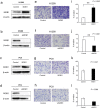Association of Mps one binder kinase activator 1 (MOB1) expression with poor disease-free survival in individuals with non-small cell lung cancer
- PMID: 32841529
- PMCID: PMC7529568
- DOI: 10.1111/1759-7714.13608
Association of Mps one binder kinase activator 1 (MOB1) expression with poor disease-free survival in individuals with non-small cell lung cancer
Abstract
Background: Mps one binder kinase activator 1 (MOB1) is a core component of the Hippo signaling pathway and has been implicated as a tumor suppressor. Here, we evaluated the possible relationship of MOB1 expression in non-small cell lung cancer (NSCLC) to prognosis.
Methods: We retrospectively analyzed 205 lung adenocarcinoma patients treated at Kyushu University Hospital between November 2007 and October 2012. MOB1 expression in tumor cells of surgical specimens was evaluated by immunohistochemistry. Invasive activity of NSCLC cell lines in vitro was measured with a transwell assay.
Results: Expression of MOB1 was classified as high in 105 of the 205 (51.2%) tumor specimens, and such high expression was significantly associated with poor disease-free survival (P = 0.0161). Among the various clinicopathologic parameters examined, high MOB1 expression was significantly associated only with intratumoral vascular invasion (P = 0.0005). Multivariate analysis also identified high MOB1 expression as a significant independent risk factor for disease-free survival (P = 0.0319). The invasiveness of H1299 cells in vitro was increased or attenuated by overexpression or knockdown of MOB1, respectively.
Conclusions: Our results suggest that MOB1 might promote early recurrence of NSCLC by increasing vascular invasion by tumor cells.
Key points: SIGNIFICANT FINDINGS OF THE STUDY: We found that high MOB1 expression in surgical specimens of lung adenocarcinoma was associated with poor disease-free survival and with intratumoral vascular invasion. MOB1 expression also promoted the invasiveness of NSCLC cells in vitro.
What this study adds: Our results thus suggest that high MOB1 expression is a risk factor for early postoperative recurrence in lung adenocarcinoma.
Keywords: Hippo pathway; MOB1; immunohistochemistry; lung adenocarcinoma; vascular invasion.
© 2020 The Authors. Thoracic Cancer published by China Lung Oncology Group and John Wiley & Sons Australia, Ltd.
Figures


 ) MOB1 low expression, (
) MOB1 low expression, ( ) MOB1 high expression. The P‐values were determined by the log‐rank test.
) MOB1 high expression. The P‐values were determined by the log‐rank test.
References
Publication types
MeSH terms
Substances
Grants and funding
LinkOut - more resources
Full Text Sources
Medical
Research Materials

